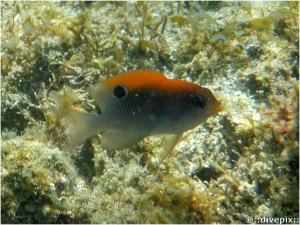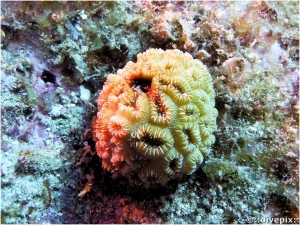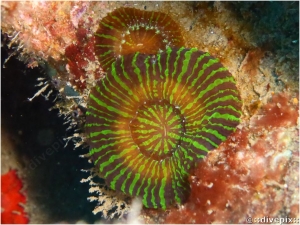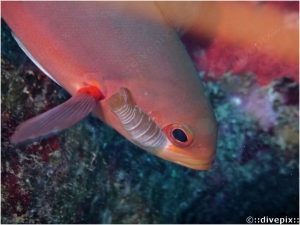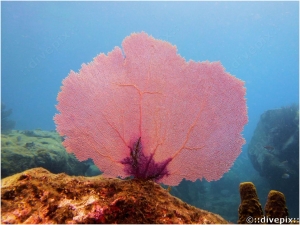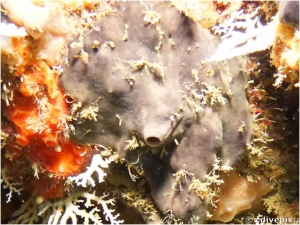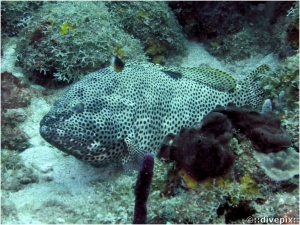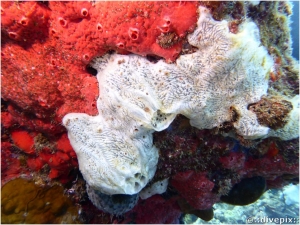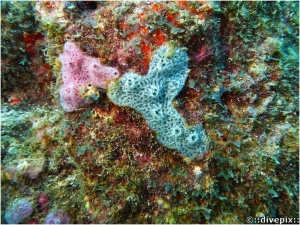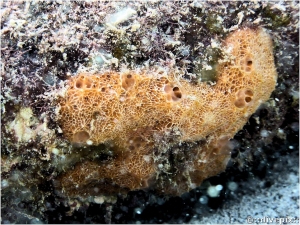




Eric H. Biass
Dusky Damselfish
| Aspect: |
Adult is brown and almost similar to Longfin Damselfish (q.v.), but dorsal fin does not extend beyond the root of the tail fin. Juvenile features a bright orange dorsal coat from snout to near the tail area, tail that washes out into a paler shade on the sides and finally into whitish belly and tail fin areas. |
| Population: | Less common than other Damselfishes. |
| Notable feature: | Juvenile: Dorsal fin features a white-bezelled dark spot in it s after half, and a similar but smaller stain saddes the tail root. Nose and eyes are adorned with seemingly fluo blue dots that fade past the gill area. |
| Environment: | Usually found in shallow waters around rocks down to a maximum depth of 15 metres. |
| Behaviour: | Will usually tolerate a diver's quiet presence, but constantly moves and is thus difficult to photograph. |
Golf Ball Coral
| Aspect: | Not entirely spherical as its name would tend to suggest, it at first sight looks like a tight conglomeration of Smooth Flower Coral (q.v.) but there is no gap between the coralites, which themselves tend to be rounder and less protuberant. |
| Population: | Not rare, but difficult to spot. |
| Notable feature: | Beige/suede colour, not to be confused with the larger Elliptical Star Coral, which is a Meandrinidae. |
| Environment: | Grows on rocky substrates. |
| Behaviour: | - |
Solitary Disc Coral
| Aspect: | The polyp ressembles a thick-edged tea cup saucer and can sport a range colours. A close look reveals a rough surface though. This species is known as solitary although the other two varieties (Artichoke and Atlantic Mushroom, q.v.) also grow in an isolated manner (as opposed to colonies). The central mouth slit is often visible in the centre of the usually concave disc centre. |
| Population: | Common. |
| Notable feature: | CAUTION: Although there are three distinct species of such small disc-shaped coral in the area - Artichoke Coral or Scolymia cubensis, Solitary Disc Coral or Scolymia wellsi, and Atlantic Mushroom Coral or Scloymia lacera - which can only be differentiated with certainty by a microscopic observation of their corallite structure (and more particularly the shape of tip of their septa), the latter can be distinguished by its considerably rougher surfaces. Other visual cues that help telling an Artichoke Coral from a Solitary Disc Coral involve the central surfaces, which tend to be convex in the former and concave in the latter. |
| Environment: | Usually found against rock or boulder walls. |
| Behaviour: | - |
Anilocra Isopod spp
| Aspect: | Light brown carapace made of seven main overlapping plates like those of wood roaches (cockroaches), followed by a series of five much smaller ones that constitute the tail. Its small legs are almost invisible and have grips that hook onto the fish. The rear edge of the dorsal plates are slightly lighter in colour. |
| Population: | Occasional. |
| Notable feature: | Starts life as a male, but changes gender when approached by another male. |
| Environment: | Attaches close to eye of fishes and is therefore an ectoparasite. |
| Behaviour: | A small larva-sized animal first lands on its victim to which it attaches for life. It is not quite clear whether these creatures entirely feed off the fish by sucking its blood, or off passing specs of food passing by as the fish eats its prey, which would account for the preferred position near the mouth. It may use both options. |
Common Sea Fan
| Aspect: | A delicate thin, single-plane lattice that spreads from several main branches. Very similar in shape and colour (generally tan or light green, often with pink/purple root and main branches) to other sea fans. |
| Population: | Common. |
| Notable feature: | The only visual way of distiguishing the Common Sea Fan from the similar Venus Sea Fan (q.v.) is to take a close-up view of its structure: if the thin branches that constitute the latice (and which homes the coral polyps) are relatively flat on either side of the main plane it is a Common Sea Fan. On the Venus Sea Fan they are clearly rounded. |
| Environment: | From shallow waters all the way down to 30 metres, but rare specimens have been seen as deep as 50 metres. Often oriented against the current for better water sifting action. |
| Behaviour: | Easily break under careless diver fin action, reason why shallow water specimens are often damaged. |
Brown Variable Sponge
| Aspect: | Dull tan (more than brown) encrusting mass with clearly protruding excurrent openings. |
| Population: | Not too common. |
| Notable feature: | Unattractive. |
| Environment: | Under overhanging rocks or cave ceilings. |
| Behaviour: | - |
Rock Hind (Pale Variation)
| Aspect: |
Preliminary remark: This "Pale Variation" has its separate entry purely for identification reasons as its colour scheme gives it a disctinctive appearance compared with the other Rock Hinds (q.v.). This variation also appears to be somewhat larger than the other Rock Hinds in this region. Typical massive grouper outline, with thick lips and prominent eyes. Compared with the other hinds, it sports a white or pale beige coat bespeckled with almost black dots, a pattern that extends over the full length of the tail fin. In addition to the darker blotches that straddle the tail root, similar, but larger blotches straddle the centre and forward areas of the dorsal fin with yet a lighter patch ahead of this. |
| Population: |
Less common. |
| Notable feature: | Grey-ish elongated patches run from nose across the eyes and slightly beyond. |
| Environment: | Close to bottom in quiet waters, around rocks and coral boulder recesses. |
| Behaviour: | Shy. |
White Encrusting Sponge
| Aspect: |
Preliminary Remark: The species seen here has not been formally identified and to our knowledge does not appear to have been described, hence tentative "White Encrusting Sponge" designation. White with "veinous" prominent excurrent openings, its structure visually appears loose in its lower areas. |
| Population: | Uncommon, first seen in late 2015. |
| Notable feature: | - |
| Environment: | Rocky substrate, spreads amongst other sponges. |
| Behaviour: | - |
Blue or Pink Icing Sponge spp.
| Aspect: |
Preliminary Remark: The species seen here has not been formally identified and to our knowledge does not appear to have been described. Pink or blue, this encrusting sponge shares similar texture features with the Orange Icing Sponge (q.v.), particularly a loose texture giving an appearance of decay. It also features similar transparent excurrent chimney brims, but does not appear to spread under sheets of coral. |
| Population: | Rare, first seen in late 2015 around Ilets Pigeon. |
| Notable feature: | - |
| Environment: | Rocky substrate. |
| Behaviour: | - |
Orange Lumpy Encrusting Sponge
| Aspect: | Orange, highly structured surface mat in which excurents appear as larger orifices amongst the other holes of the structure. |
| Population: | Common. |
| Notable feature: | - |
| Environment: | Tends to grow on coral boulders. |
| Behaviour: | - |



